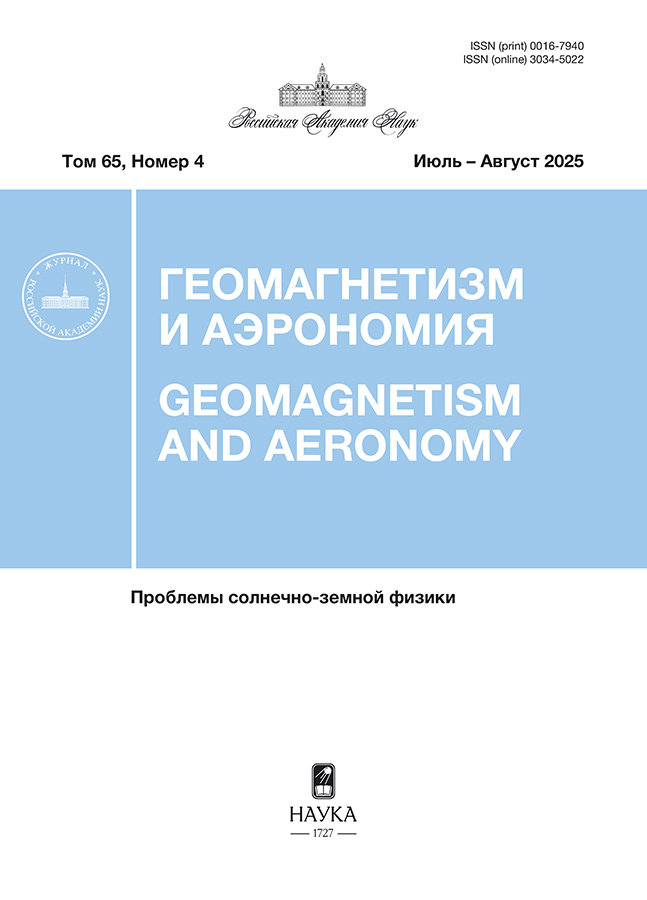Differences in monthly medians of foF2 within seasons in the mid-latitude ionosphere during the period of low solar activity in 2007–2008 years
- 作者: Hegai V.V.1, Legenka A.D.1, Korsunova L.P.1
-
隶属关系:
- Pushkov Institute of Terrestrial Magnetism, Ionosphere, and Radio Wave Propagation of the Russian Academy of Sciences (IZMIRAN)
- 期: 卷 65, 编号 4 (2025)
- 页面: 513-526
- 栏目: Articles
- URL: https://pediatria.orscience.ru/0016-7940/article/view/688315
- DOI: https://doi.org/10.31857/S0016794025040096
- EDN: https://elibrary.ru/EYFTJD
- ID: 688315
如何引用文章
详细
The paper presents a comparative analysis of diurnal variations in the monthly median critical frequency of the regular ionospheric F2 layer (foF2) for all “standard” seasons during the period of low solar activity in 2007–2008. The hourly data from manual processing of measurements taken at mid-latitude ground-based vertical ionospheric sounding stations Wakkanai (Japan) and Hobart (Australia) located almost symmetrically relative to the geographic equator were analyzed. It is found that the relative differences in the median of the third month of any of the “standard” seasons compared to the median of the second month of the season are significantly higher than the differences in the median of the first month of the season relative to the median of the second month of the season. It is also shown using a specific example of these two mid-latitude stations that, according to their characteristics, the median of November (the last month of the autumn season) corresponds to the beginning of the winter season, and the median of May (the last month of the spring season) – to the beginning of the summer season. It has been established that the relative contribution of solar radiation to changes in the value of the electron concentration at the maximum of the F region (NmF2) under conditions of low solar activity in equinoctial seasons, associated with variations in the value and rate of change of the solar zenith angle, is no less than half of the relative contribution to changes in NmF2 made by variations in the composition of the neutral atmosphere.
全文:
作者简介
V. Hegai
Pushkov Institute of Terrestrial Magnetism, Ionosphere, and Radio Wave Propagation of the Russian Academy of Sciences (IZMIRAN)
编辑信件的主要联系方式.
Email: hegai@izmiran.ru
俄罗斯联邦, Moscow, Troitsk
A. Legenka
Pushkov Institute of Terrestrial Magnetism, Ionosphere, and Radio Wave Propagation of the Russian Academy of Sciences (IZMIRAN)
Email: leg@izmiran.ru
俄罗斯联邦, Moscow, Troitsk
L. Korsunova
Pushkov Institute of Terrestrial Magnetism, Ionosphere, and Radio Wave Propagation of the Russian Academy of Sciences (IZMIRAN)
Email: lpkors@rambler.ru
俄罗斯联邦, Moscow, Troitsk
参考
- Деминов М.Г., Деминова Г.Ф., Жеребцов Г.А., Пирог О.М., Полех Н.М. Изменчивость параметров максимума F2-слоя спокойной среднеширотной ионосферы при низкой солнечной активности: 1. Статистические свойства // Геомагнетизм и аэрономия. Т. 51. № 3. С. 352–359. 2011.
- Дэвис К. Радиоволны в ионосфере. М.: Мир, 502 с. 1973.
- Легенька А.Д., Корсунова Л.П., Хегай В.В. Некоторые особенности в суточном ходе месячных медиан foF2 в зимний период по данным наземных станций вертикального зондирования ионосферы японского региона / Общероссийская открытая научная конференция “Пушковские чтения: магнетизм на Земле и в Космосе”.15–16 мая 2019 г., ИЗМИРАН, г. Москва, г. Троицк. Сборник расширенных тезисов докладов. С. 103−106. http://www.izmiran.ru/library/pushkov2019/pushkov2019abs.pdf
- Михайлов А.В. Ионосферные возмущения и их прогнозирование / “Энциклопедия низкотемпературной плазмы”. Серия Б. Справочные приложения, базы и банки данных. Том 1–3. Ионосферная плазма. Ч. 2. / Отв. ред. В.Д. Кузнецов, Ю.Я. Ружин. М: ЯНУС-К. С. 182–214. 2009.
- Отнес Р., Эноксон Л. Прикладной анализ временных рядов. Основные методы. М.: Мир, 428 с. 1982.
- Ришбет Г., Гарриот О.К. Введение в физику ионосферы. Л.: Гидрометеоиздат, 304 с. 1975.
- Руководство URSI по интерпретации и обработке ионограмм. М.: Наука, 343 с. 1977.
- Фаткуллин М.Н., Зеленова Т.И., Козлов В.К., Легенька А.Д., Соболева Т.Н. Эмпирические модели среднеширотной ионосферы. М.: Наука, 256 с. 1981.
- Chapman S. The absorption and dissociative or ionizing effect of monochromatic radiation in an atmosphere on a rotating Earth // P. Phys. Soc. V. 43. № 1. P. 26–46. 1931. https://doi.org/10.1088/0959-5309/43/1/305
- Codrescu M.V., Fuller-Rowell T.J., Munteanu V., Minter C.F., Millward G.H. Validation of the Coupled Thermosphere Ionosphere Plasmasphere Electrodynamics model: CTIPE-Mass Spectrometer Incoherent Scatter temperature comparison // Space Weather. V. 6. № 9. ID S09005. 2008. https://doi.org/10.1029/2007SW000364
- Danilov A.D., Laštovička J. Effects of geomagnetic storms on the ionosphere and atmosphere // International Journal of Geomagnetism and Aeronomy. V. 2. № 3. P. 209–224. 2001. https://elpub.wdcb.ru/journals/ijga/v02/gai99312/gai99312.htm
- https://ccmc.gsfc.nasa.gov/modelweb/models/nrlmsise00.php
- https://ccmc.gsfc.nasa.gov/publication-policy
- https://www.izmiran.ru/ionosphere/smf2/
- https://www.swpc.noaa.gov/products/solar-cycle-progression
- Mikhailov A.V. Ionospheric F2-layer storms // Fisica de la Tierra. V. 12. P. 223–262. 2000.
- Mikhailov A.V., Schlegel K. Equinoctial transitions in the ionosphere and thermosphere // Ann. Geophys. V. 19. № 7. P. 783–796. 2001. https://doi.org/10.5194/angeo-19-783-2001
- Prölss G.W. Ionospheric F-region storms / Handbook of Atmospheric Electrodynamics. V. 2. / Еd. Volland H. Ch.8. Boca Raton, FL USA: CRC Press. P. 195–248. 1995. https://doi.org/10.1201/9780203713297
- Rishbeth H., Muller-Wodarg I.C.F., Zou L., Fuller-Rowell T.J., Millward G.H., Moffett R.J., Idenden D. W., Aylward A. D. Annual and semiannual variations in the ionospheric F2-layer. II. Physical discussion // Ann. Geophys. V. 18. № 8. P. 945–956. 2000. https://doi.org/10.1007/s00585-000-0945-6
- Zou L., Rishbeth H., Müller-Wodarg I.C.F., Aylward A.D., Millward G.H., Fuller-Rowell T.J., Idenden D.W., Moffett R.J. Annual and semiannual variations in the ionospheric F2-layer. I. Modelling // Ann. Geophys. V. 18. № 8. P. 927–944. 2000. https://doi.org/10.1007/s00585-000-0927-8
补充文件
















